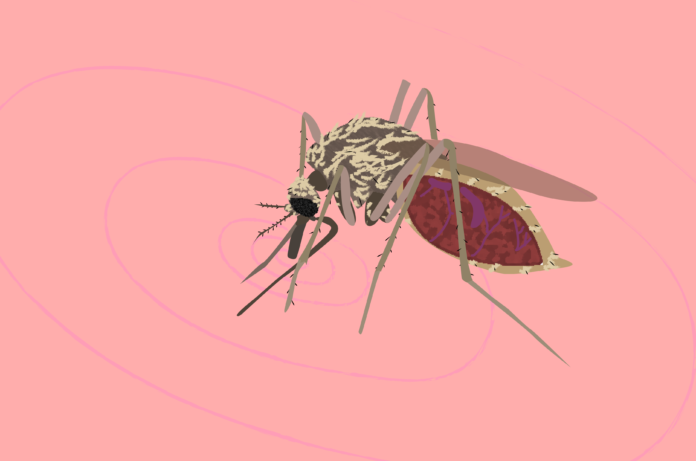Genetically engineered mosquitoes join fight against vector borne illness
Malaria is one of the most significant vector borne illnesses known to humans, causing 500,000 deaths each year, according to the World Health Organization. Mosquitoes, a majority of the genus Anopheles, transmit the plasmodium parasite to humans. Malaria control-tactics rely largely on resources such as insecticides — which are costly and becoming less and less effective as mosquitoes grow resistant. So new management strategies are being researched.
“The conventional methods of treating malaria such as drugs or insecticides [are] very expensive and labor intensive,” said Gregory Lanzaro, a professor in the Department of Pathology, Microbiology and Immunology. “That got us thinking about using the mosquito itself to produce a cost-effective and sustainable way to control malaria.”
For the past 30 years, researchers have studied the usage of gene drive technology to stop the spread of malaria. The idea is to create genetically engineered mosquitoes (GEM) that are either resistant to carrying the malaria parasite or that fail to reproduce, which would result in the reduction of the mosquito population. The gene drive technology relies on the use of the Cas-9 enzyme, which ensures the passing of the new modified genes onto offspring in the introduced population.
Concerns over the success of this technology arose due to the high sequence variation in the genomes of mosquito species. The Cas-9 enzyme requires a specific 23 base pair stretch of target DNA to be effective.
“For the GEM strategy to work, it is essential to have a sequence of DNA that is identical in almost every specimen of the target population,” said Hanno Schmidt, a postdoctoral researcher, via email.
Researchers began to question the viability of this technique, as many thought wild mosquitoes might not have the specific target DNA, which could result in individuals carrying the variation resistant to the drive.
“People were worried about using Cas-9 because mosquito genomes are very polymorphic and have lots of base pair substitutions,” Lanzaro said. “The concern was that it would be hard to find a 23 base pair sequence that didn’t have some variation which could lead to the Cas-9 not working.”
A recent study conducted by entomologists in the Vector Genetics Lab, led by Lanzaro, alleviates these concerns, as it proves the success of the technology despite the high variation in the genomes across mosquito species.
The lab determined that 90% of all protein-encoding genes include at least one Cas-9 target site. The researchers obtained these results through examining the genomes of three different species of mosquitoes. A total of 1,200 whole genome sequences collected by the lab and the Ag1000g Consortium, a research project being conducted by MaleriaGen, were examined for potential target sites. This large collection of genome sequence data allowed the researchers to dismiss concerns over the potential failure of gene drive.
With confidence in the success of gene drive, further progress can be made in this field. The Vector Genetics Lab works closely with UC Irvine’s Malaria Initiative, which leads a population modification approach to treating malaria. The goal is to use gene drive to stop mosquitoes from transmitting the malaria parasite.
“Professor Anthony James and his team at UC Irvine advance the laboratory strain of the modified mosquitoes,” Schmidt said via email. “The Vector Genetics Lab currently investigates natural populations at African oceanic islands that are potential targets for initial field release trials.”
Leading the field application aspect of the project, the Vector Genetics Lab selected two African island nations, the Republic of São Tome and Príncipe and the Union of Comoros, as potential field sites. The research is in the initial stages as they work to understand the population genetics of the mosquitoes native to the islands.
“On the science side, we need to have a very thorough understanding of the mosquitoes on the islands and their ecology,” Lanzaro said. ”Our goal is to understand mosquito biology from the perspective of malaria transmission in a broad site.”
An equally important aspect of their work on the island is community engagement and education. The team works closely with the National Malaria Control Programs of each field site.
“In the next several years there is a lot of education that needs to happen in the highest level of the countries,” said Ana Kormos, the community engagement manager for UCI’s Malaria Initiative. “At the same time, really building some strong relationships with different groups within the countries on how they feel about malaria and how they might respond to a field trial.”
The lab produces a large amount of educational materials on gene drive technology and the research process, such as what a GEM is and why these countries may want to consider implementing GEMs. This helps inform and build relationships with the countries as they decide whether or not to approve the release of GEMs.
“Even if we are not able to release them at these islands, we would still have a lot of information on the malaria transmission on these islands for them to use in a more conventional way,” Lanzaro said.
While no GEMs have yet been released, the potential benefits of this technology are immense. As a cost-effective and highly efficient control tactic, gene drive could greatly reduce the spread of not only malaria but many other mosquito transmitted diseases such as zika, dengue fever and yellow fever.
Written by: Alma Meckler-Pacheco — science@theaggie.org




